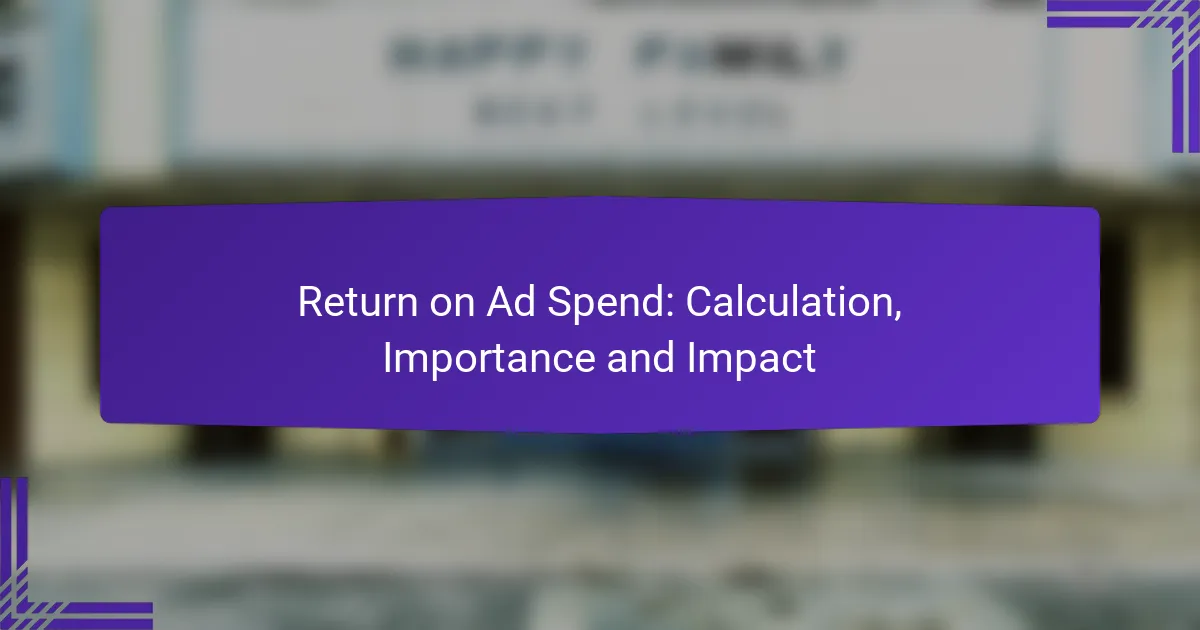Return on Ad Spend (ROAS) is a vital metric that measures the revenue generated for every dollar spent on advertising, providing businesses with insights into the effectiveness of their marketing campaigns. By calculating ROAS, companies can assess their advertising performance and make informed decisions to optimize their strategies for improved profitability.

How to calculate Return on Ad Spend in Canada?
Return on Ad Spend (ROAS) in Canada is calculated by dividing the revenue generated from ads by the total cost of those ads. This metric helps businesses assess the effectiveness of their advertising campaigns and determine whether they are generating a profitable return.
Formula for ROAS calculation
The formula for calculating ROAS is straightforward: ROAS = Revenue from Ads / Cost of Ads. This ratio indicates how much revenue is earned for every dollar spent on advertising. A ROAS greater than one signifies a profitable campaign, while a ratio below one indicates a loss.
Example of ROAS calculation
For instance, if a Canadian business spends CAD 1,000 on an advertising campaign and generates CAD 5,000 in revenue, the ROAS would be calculated as follows: ROAS = 5,000 / 1,000 = 5. This means the business earns CAD 5 for every CAD 1 spent on ads, indicating a highly effective campaign.
Tools for calculating ROAS
Several tools can assist in calculating ROAS effectively. Google Ads provides built-in reporting features that allow users to track ad spend and revenue. Additionally, analytics platforms like HubSpot and Adobe Analytics can offer insights into campaign performance and help automate ROAS calculations.
Using spreadsheets can also be a simple method for calculating ROAS. By inputting revenue and ad costs, businesses can quickly compute their ROAS and analyze trends over time.

Why is Return on Ad Spend important for advertisers?
Return on Ad Spend (ROAS) is crucial for advertisers as it measures the revenue generated for every dollar spent on advertising. Understanding ROAS helps businesses evaluate the effectiveness of their marketing campaigns and optimize their strategies for better profitability.
Impact on advertising strategy
ROAS directly influences advertising strategy by providing insights into which campaigns are performing well and which are not. Advertisers can identify high-performing channels and allocate resources accordingly, ensuring that their efforts are focused on the most effective tactics.
For example, if a campaign yields a ROAS of 400%, it indicates that for every dollar spent, four dollars are earned. This information can lead to increased investment in that campaign while reducing or eliminating spending on less effective ones.
Influence on budget allocation
Understanding ROAS is essential for effective budget allocation. Advertisers can prioritize spending on channels and campaigns that deliver the highest returns, ensuring that their marketing budgets are used efficiently. This approach minimizes waste and maximizes overall revenue.
As a practical tip, advertisers should regularly analyze their ROAS data to adjust budgets dynamically. For instance, if a particular ad group consistently shows a ROAS above 300%, consider increasing its budget by a percentage that reflects its performance, while reducing funds from underperforming areas.

What factors affect Return on Ad Spend?
Return on Ad Spend (ROAS) is influenced by several key factors that can significantly impact the effectiveness of advertising campaigns. Understanding these factors helps businesses optimize their ad strategies for better financial performance.
Ad campaign objectives
The objectives of an ad campaign play a crucial role in determining its ROAS. Clear goals, such as increasing brand awareness, generating leads, or driving sales, will shape the strategies employed and the metrics used to measure success. For instance, campaigns focused on direct sales may prioritize immediate conversions, while those aimed at brand awareness might measure engagement metrics instead.
When setting objectives, ensure they are specific, measurable, achievable, relevant, and time-bound (SMART). This clarity allows for better tracking of performance and adjustments to improve ROAS over time.
Target audience demographics
Understanding the demographics of your target audience is essential for maximizing ROAS. Factors such as age, gender, income level, and interests can influence how effectively your ads resonate with potential customers. Tailoring your messaging and creative elements to align with these demographics can lead to higher engagement and conversion rates.
Utilize data analytics tools to gather insights about your audience. This information can help refine targeting strategies, ensuring that your ads reach the right people at the right time, ultimately improving your return on investment.
Ad placement and format
The placement and format of your ads significantly affect their visibility and effectiveness, impacting ROAS. Different platforms, such as social media, search engines, or display networks, offer unique advantages and audience reach. Choosing the right platform based on your target audience’s habits can enhance ad performance.
Additionally, consider the format of your ads—whether they are text-based, images, videos, or interactive content. Experimenting with various formats can help identify which ones yield the best results for your specific objectives and audience, leading to improved ROAS.

How does Return on Ad Spend impact business growth?
Return on Ad Spend (ROAS) significantly influences business growth by measuring the revenue generated for every dollar spent on advertising. A higher ROAS indicates effective ad campaigns that contribute positively to overall revenue, enabling businesses to scale operations and invest in further marketing efforts.
Correlation with revenue growth
ROAS directly correlates with revenue growth, as it quantifies the effectiveness of advertising investments. For instance, if a company spends $1,000 on ads and generates $5,000 in revenue, the ROAS is 5:1, indicating strong performance. Businesses typically aim for a ROAS of at least 4:1 to ensure profitability.
Understanding this correlation helps businesses allocate budgets wisely. By analyzing ROAS across different campaigns, companies can identify which ads drive the most revenue and optimize their marketing strategies accordingly.
Effect on customer acquisition cost
ROAS impacts customer acquisition cost (CAC) by providing insights into how much is spent to acquire each customer. A favorable ROAS suggests that the cost to acquire customers is lower relative to the revenue generated, which is essential for sustainable growth. For example, if the CAC is $100 and the revenue per customer is $500, the ROAS would be 5:1.
To improve CAC, businesses should focus on optimizing their ad targeting and creative strategies. Avoiding overspending on ineffective ads and continuously testing different approaches can lead to a more favorable ROAS and lower CAC, ultimately enhancing profitability.

What are the best practices for optimizing Return on Ad Spend?
To optimize Return on Ad Spend (ROAS), focus on continuous improvement through testing, audience targeting, and data analysis. Implementing best practices can significantly enhance the effectiveness of your advertising efforts and maximize profitability.
Testing and refining ad creatives
Regularly testing and refining ad creatives is essential for improving ROAS. Experiment with different headlines, images, and calls to action to identify which combinations resonate most with your audience. A/B testing can help you determine the most effective elements.
Consider using analytics tools to track performance metrics such as click-through rates and conversion rates. This data will guide you in making informed decisions about which creatives to keep, modify, or discard. Aim for a testing cycle of a few weeks to gather sufficient data before making changes.
Utilizing audience segmentation
Audience segmentation allows you to tailor your advertising efforts to specific groups, enhancing ROAS. By dividing your audience based on demographics, interests, or behaviors, you can create more personalized and relevant ads that drive better engagement.
Use tools like Google Ads or Facebook Ads Manager to set up targeted campaigns for different segments. For example, a campaign targeting young adults may focus on social media platforms, while one aimed at older consumers might utilize email marketing. Regularly review and adjust your segments based on performance data to ensure optimal results.

What trends are shaping Return on Ad Spend in 2024?
In 2024, Return on Ad Spend (ROAS) is increasingly influenced by emerging technologies and shifts in consumer behavior. Advertisers must adapt to these trends to optimize their campaigns and maximize profitability.
Emerging technologies in advertising
Technological advancements are revolutionizing how advertisers track and analyze ROAS. Tools powered by artificial intelligence and machine learning enable more precise targeting and real-time adjustments, leading to improved campaign performance.
For instance, programmatic advertising platforms allow for automated ad buying, optimizing spend based on performance metrics. This can result in a more efficient allocation of budget, often increasing ROAS by targeting the most responsive audiences.
Changes in consumer behavior
Consumer behavior is evolving, with increased emphasis on personalization and authenticity. Shoppers are more likely to respond positively to ads that resonate with their values and preferences, making tailored messaging essential for effective advertising.
Additionally, the rise of mobile shopping and social media influences how consumers interact with brands. Advertisers should focus on creating engaging, mobile-friendly content that captures attention quickly, as studies suggest that effective mobile ads can significantly enhance ROAS.
